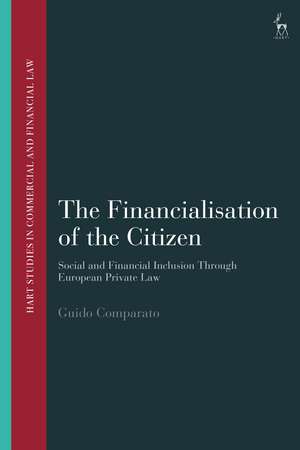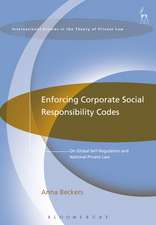The Financialisation of the Citizen: Social and Financial Inclusion through European Private Law: Hart Studies in Commercial and Financial Law
Autor Guido Comparatoen Limba Engleză Hardback – 22 aug 2018
| Toate formatele și edițiile | Preț | Express |
|---|---|---|
| Paperback (1) | 297.50 lei 6-8 săpt. | |
| Bloomsbury Publishing – 25 noi 2020 | 297.50 lei 6-8 săpt. | |
| Hardback (1) | 568.40 lei 6-8 săpt. | |
| Bloomsbury Publishing – 22 aug 2018 | 568.40 lei 6-8 săpt. |
Din seria Hart Studies in Commercial and Financial Law
- 30%
 Preț: 837.63 lei
Preț: 837.63 lei - 30%
 Preț: 539.78 lei
Preț: 539.78 lei - 18%
 Preț: 305.59 lei
Preț: 305.59 lei - 30%
 Preț: 512.04 lei
Preț: 512.04 lei - 34%
 Preț: 510.60 lei
Preț: 510.60 lei - 34%
 Preț: 512.30 lei
Preț: 512.30 lei - 22%
 Preț: 271.58 lei
Preț: 271.58 lei - 18%
 Preț: 297.50 lei
Preț: 297.50 lei - 22%
 Preț: 264.10 lei
Preț: 264.10 lei - 18%
 Preț: 311.36 lei
Preț: 311.36 lei - 18%
 Preț: 321.78 lei
Preț: 321.78 lei - 18%
 Preț: 305.31 lei
Preț: 305.31 lei - 18%
 Preț: 304.29 lei
Preț: 304.29 lei - 18%
 Preț: 319.58 lei
Preț: 319.58 lei - 30%
 Preț: 511.57 lei
Preț: 511.57 lei - 30%
 Preț: 511.40 lei
Preț: 511.40 lei - 30%
 Preț: 511.64 lei
Preț: 511.64 lei
Preț: 568.40 lei
Preț vechi: 815.70 lei
-30% Nou
108.77€ • 112.92$ • 90.70£
Carte tipărită la comandă
Livrare economică 22 martie-05 aprilie
Specificații
ISBN-10: 1509919228
Pagini: 232
Dimensiuni: 156 x 234 x 21 mm
Greutate: 0.48 kg
Editura: Bloomsbury Publishing
Colecția Hart Publishing
Seria Hart Studies in Commercial and Financial Law
Locul publicării:London, United Kingdom
Caracteristici
Notă biografică
Guido Comparato is a lecturer in law at Birkbeck, University of London.
Cuprins
Introduction I. The Scenario II. Inclusion, Finance and Private Law III. Methodology IV. Structure 1. The Idea of Financial and Social Inclusion I. Dimensions of Financial and Social Inclusion II. The Rise of Social Inclusion and Its Merging with Financial Inclusion III. The Transformations of State and Law IV. Financialisation V. Privatised Keynesianism and Democratisation of Finance VI. The Role of TrustVII. Passing the Risk VIII. The Other Side of the Coin IX. Re-regulation? 2. Financial and Social Inclusion in the European Legal Order I. An EU Affair II. Distinguishing the Forms of Inclusion in Europe A. Financial Inclusion B. Market Inclusion C. Social Inclusion III. A Just or an Inclusive Private Law?A. Social Inclusion and Social Justice B. Market Inclusion and Access Justice IV. The Rise of Inclusion in European Law A. Social Exclusion B. Financial Exclusion V. In European Contract Law 3. Access to a Bank Account I. A Gateway to the Market II. Legal Frameworks in Europe III. The Problems of Overdrafts IV. EU Involvement V. The Recommendation VI. The Problem of Reasonable Costs VII. The New Directive 4. Access to Credit I. From a Right to a Bank Account to a Right to Credit?II. Responsible Lending and the Problem of Self-Interest III. Responsible Lending and European Contract Law IV. Access to Information V. Post-Crisis Responses and the Mortgage Credit Directive VI. The Public-Private Problem VII. Financial Stability and Exclusion VIII. Back to Trust5. Over-Indebtedness I. How Much is too Much? II. Legal Responses III. Causes of Over-Indebtedness and their Legal Appreciation IV. A Categorisation of Private Law Responsesto Over-Indebtedness A. Contract Law Ex Ante Instruments B. Contract Law Ex Post Instruments C. Non-Contract Law Instruments V. European Over-Indebtedness Law 6. Financial Education I. Just Gonna have to be a Different Man II. The Rise of the Policy of Financial Education III. Critical Aspects of the Policy of Financial Education IV. Interference with Contract Law Conclusion
Recenzii
Descriere
This book discusses the role of private law as an instrument to produce financial and social inclusion in a context characterised by the redefinition of the role of the State and by the financialisation of society. By depicting the political and economic developments behind the popular idea of financial inclusion, the book deconstructs that notion, illustrating the existence and interaction of different discourses surrounding it. The book further traces the evolution of inclusion, specifically in the European context, and thus moves on to analyse the legal rules which are most relevant for the purposes of bringing about the financialisation of the citizen. Hence, the author focuses more on four highly topical areas: access to a bank account, access to credit, over indebtedness, and financial education. Adopting a critical and inter-disciplinary approach, The Financialisation of the Citizen takes the reader through a top-down journey starting from the political economy of financialisation, to the law and policy of the European Union, and finally to more specific private law rules.












